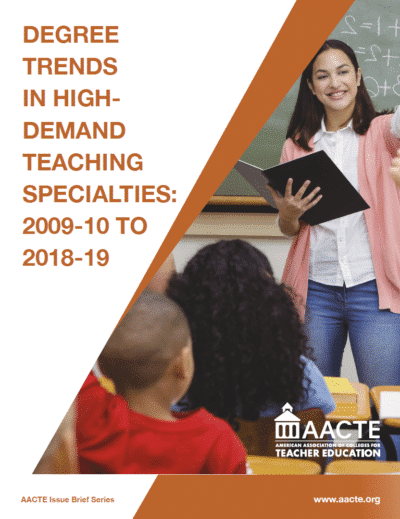Issue Brief: Degree Trends in High-Demand Teaching Specialties

This issue brief (2020) provides detailed information on degree trends since 2009-10 in the following teaching specialties, which the U.S. Department of Education has identified as in high demand around the country: special education, mathematics and science education, teaching English as a second language, and foreign language education.
It examines the following key trends:
- Degree production in the high-demand fields, including a comparison of those trends to degree production in education overall and across all fields
- The number and type of institutions awarding degrees in the high-demand specialties
- The racial/ethnic and gender profile of degree recipients in the high-demand specialties, again comparing these specialties to education overall and to all fields
These analyses encompass the three primary degree programs offered by schools, colleges, and departments of education to prepare classroom teachers: bachelor’s degrees, master’s degrees, and post-baccalaureate (post-BA/BS) certificates. An appendix table, provides detailed information on degree completion in these high-demand fields by state in 2009-10 and 2018-19.
Total degree production across these three degree types experienced a 17 percent increase in English as a second language, was down slightly in special education, and fell substantially in science and mathematics and foreign language education between 2009-10 and 2018-19, the most recent year for which data are available. Special education and English as a second language defied the general trend of declining interest in education as a field of study, with degree production in English as a second language outpacing overall degree production across higher education. Despite these more positive degree trends, teacher shortages persist due to an array of factors that may include an inability to attract and/or retain teachers and increasing need for these specializations.
A closer look at trends within the four specialties reveals important differences by type of degree and subspecialty:
- While general programs in special education remain popular, more students are choosing programs that concentrate on particular levels of education and on particular student conditions or attributes. Sub-specialties that gained graduates included special education for early childhood and elementary students and teaching students who have autism.
- The number of degrees conferred in both mathematics and science education fell substantially. There were significant increases over the same period in the number of mathematics and science degrees conferred outside of schools, colleges, and departments of education, but demand for those graduates across the economy could depress interest in teaching.
- The drop in the number of students earning degrees in foreign language education was matched by a similar decline in foreign language graduates outside of education
Despite a few bright spots, the trends outlined in this issue brief suggest that K-12 schools will not be able to eliminate shortages simply by recruiting newly prepared teachers. To sustain a workforce in these key areas will require a combined effort across K-12 and higher education to retain current teachers, prepare more teacher candidates in these specialties, and encourage students with mathematics, science and foreign language training and expertise to enter educator preparation programs and become teachers.
This report is available to AACTE members only.
